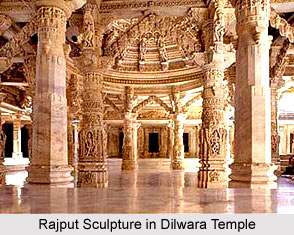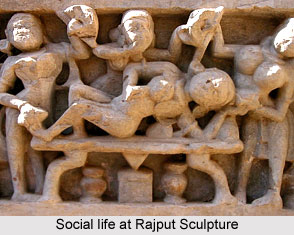 Rajput Sculptures and art received great patronage from its rulers. As a result the art and architecture under the Rajputs thrived. However, it may be pointed out that initially most of the features of Rajput sculptures were inspired from the Mughals. At a later stage Rajput sculptures and architecture evolved a new idiom for construction. The Rajput rulers were prolific builders. Hence various kinds of monuments were built by them. These included the palaces, forts, havelis and temples. Rajput sculptures that one comes across in these buildings are magnificent.
Rajput Sculptures and art received great patronage from its rulers. As a result the art and architecture under the Rajputs thrived. However, it may be pointed out that initially most of the features of Rajput sculptures were inspired from the Mughals. At a later stage Rajput sculptures and architecture evolved a new idiom for construction. The Rajput rulers were prolific builders. Hence various kinds of monuments were built by them. These included the palaces, forts, havelis and temples. Rajput sculptures that one comes across in these buildings are magnificent.
History of Rajput Sculptures
The Rajput Rulers had an enthusiastic sense of beauty in Art and Architecture which is seen in the artistic brilliance of their temples, forts and palaces. The Indo-Aryan style of architecture developed in North India. The Dravidian style of architecture and sculpture was there in South India during the Rajput period. Both sculpture and architecture attained a high degree of superiority. The Rathas of Mahabalipuram or Mamallapuram, the Kailash temple at Ellora and the sculpture of Elephanta belong to the early Rajput period. The temple architecture of Odisha, Khajuraho, Rajasthan, Madhya Pradesh and the Pallava, Chola and Hoysala temples in the South belong to the later Rajput period.
Features of Rajput Sculpture
 The features of Rajput sculpture make it quite apparent that the Rajput rulers had a keen interest and were acquainted with the sculptural idiom. Their sense of beauty is predominant in their temples, havelis, forts and palaces. The architectural grandeur of the Rajput era is extensively found in North Indian and Upper Deccan. Their kind of art was termed as the Indo-Aryan style of architecture and sculpture. However in South India the Dravidian art and sculpture thrived under their reign. A detailed study of the Rajput sculpture, painting and architecture brings forth the fact that the Rajput style of architecture heavily borrowed from the Mughals. The later 18th and 19th century Rajput buildings assumed national character when they reduced the Mughal features to a subordinate position. These buildings were more elegant that that of the Mughals.
The features of Rajput sculpture make it quite apparent that the Rajput rulers had a keen interest and were acquainted with the sculptural idiom. Their sense of beauty is predominant in their temples, havelis, forts and palaces. The architectural grandeur of the Rajput era is extensively found in North Indian and Upper Deccan. Their kind of art was termed as the Indo-Aryan style of architecture and sculpture. However in South India the Dravidian art and sculpture thrived under their reign. A detailed study of the Rajput sculpture, painting and architecture brings forth the fact that the Rajput style of architecture heavily borrowed from the Mughals. The later 18th and 19th century Rajput buildings assumed national character when they reduced the Mughal features to a subordinate position. These buildings were more elegant that that of the Mughals.
Rajput Sculptures in Temples
One of the most outstanding achievements of Rajput sculptures is the Dilwara temple. The sculpture of Dilwara Jain temple has been carved out on pristine white marble. The intricate and detailed work on the ceilings, walls and pillars of this temple are simply awe-inspiring. The sculpture of Man Mandir and Chaturbhuja temple are the other two brilliant specimens of the Rajput era. The Khajuraho temples are built of pink buff-coloured and light yellow bright grained sand-stone. The balcony windows have a shelter of overhanging roof space which is the most eye-catching features of the Khajuraho temples. The temple has an Adhishtana or base which has beautiful mouldings.
Rajput Sculptures in Palaces
The palaces and havelis reflect the influence of the Indo Islamic sculpture and architecture. In fact there are several palaces in Rajasthan where the sculpture and architecture of the Rajputs can be studied. One of the foremost amongst these will be the sculpture of Jodhpur palace. Others comprise of sculptures of Jaisalmer palace, Bikaner palace, Udaipur palace, Kota palace and Jaipur palace. The havelis in Rajasthan are unique with sculptures on the walls and in the recesses of the walls. Mural paintings are also part of the haveli architecture. Hawa Mahal is a fine instance of Rajput havelis.
Rajput Sculptures in Forts
Last but not the least the forts are architectural marvels of the Rajput kingdom. Chittorgarh fort, Gwalior fort, Jaisalmer fort, Amber fort and several others are historical witnesses to the Rajput might and valour. Other monuments like the Jantar Mantar in Jaipur bring out a completely different aspect of the Rajput architecture.



